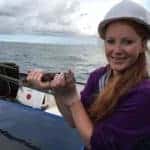-
Asked by THamm325 on 27 Nov 2023.0
-
Tanya Riley answered on 27 Nov 2023:
So all fish farms must follow their biosecurity protocols to manage this risk and these are updated whenever there is new information from research
-
-
Clemence Fraslin answered on 27 Nov 2023:
That is a good question and many labs are trying to answer it in the world. There are different level of answer.
At a farm level: there are protocols to try avoid spreading diseases. For example if the fish are in tank/raceways/recirculating systems the water is treated before it goes back to the environment so it’s clean and there are no more pathogens in it.
If the fish are in a cage in the sea it’s more complicated as it’s not possible to isolate the water that goes in and out the cage and could spread disease. That is why we work on disease resistance and vaccines.
If the farmed fish are resistant to a disease the pathogen can not reproduce and then you limit the spread (could be natural resistance, could be resistance using a vaccine, as with the covid pandemic). In research we try to understand resistance to pathogens, but also how pathogens spread between fish (with mathematical models) to try to prevent it.
We also have to treat the fish that are sick to kill the pathogen (for fish welfare, you can’t let them suffer), that limits the spread of the disease.
There is always a risk of spreading a disease between farmed and wild populations but farmers (and scientist) are working on the best way to avoid it through increasing natural resistance and also best farming practices (as treating the fish early and reducing the number of fish per cages because if you have less fish there is less opportunity for the pathogen to spread). -
Amina Moss answered on 28 Nov 2023:
Another excellent question! So, to manage pathogen transmission in aquaculture, practices like biosecurity measures and disease monitoring are absolutely essential!! There is always risk of introducing pathogens to native sea life, not just through farming but also with ships travelling from elsewhere, etc, so responsible aquaculture strives to minimize this risk through very strict protocols to prevent disease spread, protecting both farmed and wild populations.
-
Cristina Steliana Mihailovici answered on 30 Nov 2023:
Each fisheries have their own strategies and protocols.
-
Karen Edwards answered on 4 Dec 2023:
That is definitely a risk and, while it is not something I am familiar with, I do know that a lot of work is done both at the individual farm level but also with wider scientific research.
Related Questions
What is aquaculture?
do you try to maintain genetic diversity in farmed populations?
what kind of things do you do on the aquaculture farms?
have you ever got bitten by a pirahana
What is the most interesting thing about the life of a fish?
Is it possible for a fish or shrimp to overheat? If so, can they die from this?
What is your favourite type of fish to study?
Has a fish ever frozen because it was so cold
Latest Questions
-
If you had to write a story, what marine creatures would you include in it?
-
how do you manage pathogen transmission between farmed and native populations? is there a risk of introducing a
-
do you try to maintain genetic diversity in farmed populations?
-
Have you seen a shark in the wild and if so how do they react to humans in their habitat
-
What do you feel is the best thing you’ve learnt in science?
-
what challenges do u face when working? (1 Comment)
-
what life lessons have you learned whilst working there?
-
What is aquaculture?
-
How do you know where to find the Harbour Porpoises in the sea or ocean?
-
is it fun diving
Latest Comments
-
what challenges do u face when working? (1 comment)
-
You are my favourite scientist and I would like to know how long have been a scientist? (1 comment)
-
how long have you been doing this (3 comments)
-
What kind of experiments do you like to do in science class? (2 comments)
-
when did you get into oceangraphy (3 comments)







Comments